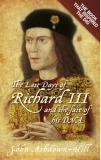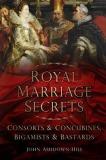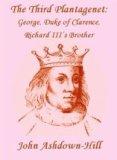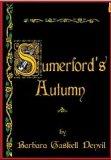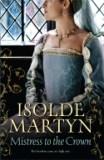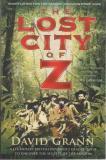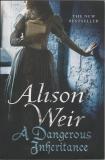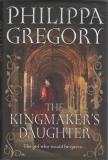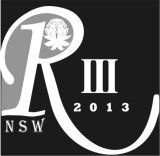 The biennial convention of the Australasian branches was held on 12 to 14 July 2013 at the Novotel, Darling Harbour Sydney. Hosted this year by the New South Wales branch, the convention attracted over 40 attendees from all the wide spread parts of Australasia. Representatives came from New Zealand across to Western Australia and all parts in between.
The biennial convention of the Australasian branches was held on 12 to 14 July 2013 at the Novotel, Darling Harbour Sydney. Hosted this year by the New South Wales branch, the convention attracted over 40 attendees from all the wide spread parts of Australasia. Representatives came from New Zealand across to Western Australia and all parts in between.
Registration was on Friday night followed by an informal meal at Pancakes on the Rocks (Darling Harbour branch), which was within easy walking distance from the venue. Several tables of keen Richardians made a good start to the weekend, setting the scene with good talk and fellowship.
Saturday started with a warm and humorous greeting from weekend Master of Ceremonies Ann (NSW) who introduced the theme for the convention. As a start to exploring “Richard III: the man behind the myth”, Ann declaimed a pair of clerihews specially written for Richard and I include a sample,
Clerihew 2
In Bosworth Field, did Richard fall
Without a horse, he was nought at all
But forget the nag, and Percy the cheater
My kingdom is for the parking meter.
She also invoked the modern poet Bob Dylan with a final piece of advice ‘don’t trust leaders and watch the parking meters.’ Despite recovering from surgery to an arm injury, Ann gently guided the convention with her special brand of persuasion and humour keeping all on track and informed.
The richly textured programme of speakers began with long term Richardian Peter from Queensland presenting for the first time at an Australasian convention. As a consulting physician for 35 years, Peter was very qualified to discuss the various kinds of deformities that Richard has been accused of having and then look at the actual new evidence from the recent discovery at Leicester. Graphically illustrated with eye catching medical slides and clearly delivered interesting information, Peter’s talk was a fresh and interesting approach. Though this was Peter’s first appearance at a convention we hope it will not be his last.
Karen (NSW), author and linguist, presented on the Fitzhughs of Ravensworth with a focus on Henry Fitzhugh, a prominent northern lord of a prominent northern family. This detailed and interesting examination was enlivened with shots of humour. Karen was an illuminating and knowledgeable guide to the turbulent events of the War of the Roses, following Henry whenever she could see him. Bringing historic names to life as a good novelist can, Karen brought strong research and human details together to bring the historical figures to life.
Beautifully illustrated with photos from her research in Norfolk, Carole’s (WA) presentation on iconography in medieval churches was informed and revealing. As well as the beautiful carved images made for the main public sections of the churches, she also showed many of the small details tucked away in architectural nooks and crannies. These ranged from amusing small animals like the singing pigs to fierce demons. This research is part of her doctoral thesis on the relationship between medieval devotional literature and iconography in medieval parish churches.
Chris (NSW) made an arresting comparison of what he identified as the four ‘invasions’ of England and their profound effect on the development of a distinctive English democracy and parliamentary and governance conventions and the role of monarch. These were 1. Roman 2. Norman at Hastings 3. Tudor at Bosworth and 4. Willaim and Mary the last of course not a military invasion but one with comparable effects on community and economy. He drew compelling parallels between these various invasions all of which he contended marked a paradigm shift for English history and culture. The contribution of Richard III was explored with the range of enduring laws and statutes enacted in his short reign. As a student of political institutions Chris has an enduring interest in how they develop and function.
NSW Branch webmaster and journal editor, Dorothea, looked at one of the lesser known characters of the period, Thomas Barowe, loyal servant to Richard III. Tracing mentions of Thomas in primary documents, she followed his career under Richard and later under Henry VII. Following some of the lesser-known characters gives a richer texture to the more mainstream stories adding to our sense of the period and how it was to live and survive and thrive in times so different to our time.
A raft of book reviews of some classic and not so classic offerings and some new additions to Richardian fiction followed. Gillian (Vic) offered a clear and warm analysis of Rosemary Hawley Jarman’s We Speak No Treason (1971), which she described as a beautifully written book and though detailed, the meshing of the fictional and historical characters was masterly and believable. A classic, which stood the test of time. Not so impressed with the new offering of Phillipa Gregory The Kingmaker’s Daughter (2012), Gillian found this novel careless and historically inaccurate, with wooden unengaging characters. Despite quite enjoying some past novels from this author she could not recommend this one at all.
Hazel (Vic) also picked a classic Richardian text with The Betrayal of Richard III (1959) by V. B. Lamb. Hazel enjoyed the clear presentation of the case for a reassessment of Richard III reputation, liking Mrs Lamb’s often dry humour and witty style, one which Hazel herself used to make this entertaining talk a reminder of this excellent classic which can be revisited with pleasure.
Margaret (NZ) looked at some contemporary local writers of Ricardian and historical fiction. The New Zealand branch journal, The Ricardian Times that Margaret has edited since 1985, has a history of supporting fiction writing with the publication of various kinds of original work from an historical Agony Aunt column to stories and poetry. Members Lorraine McArthur and Jane Orwin-Higgs have now had full length works published. A booklet of short stories from these writers was generously handed out to participants and eagerly taken up.
Moving to a slightly lighter pace, Helen and Denise (NSW) challenged attendees to identify unnamed quotes from a variety of sources on Richard III that they handed out on scrolls. This experimental game, Outrageous Fortune, looks at the changing face of opinion, conjecture and rumour peddled as history on Richard over the centuries. From well known through malicious to balanced and laudatory, the quotes had the audience on their feet reading out quotes and guessing or naming the authors. After a well earned afternoon tea for all, Helen and Denise moved on to examine the reputation of Richard in light of the Greyfriars find, looking at tweets, humour, worldwide headlines and controversy as the momentous events unfold in a very different world of communications. The hope was expressed that the exciting contemporary story of the finding of the King’s lost bones will take root in popular consciousness providing a counterbalance to the age-old image of the deformed Wicked Uncle.
The formal dinner on Saturday night celebrating the 530th anniversary of the coronation of Richard III was well attended with many in historic costume. A candle light ceremony opened proceedings accompanied by delightful evocative choral music composed by Graham Keitch who had given special permission for its use on this special night. The crowd was entertained with original songs and theatre presented by NSW members (thanks to Julia, David, Kevin and Philip) in between enjoying more delicious catering.
As the loyal toasts drew to a close, diners were stunned by a magnificent fireworks display that burst over the nearby harbour. Even discovering that this was a regular event and not another example of the immaculate timing and organization of the NSW branch committee did not lessen the enjoyment of catching a breath of fresh air on the terrace and watching the spectacle.
 Watching the fireworks (Photograph by Helen Portus)
Watching the fireworks (Photograph by Helen Portus)
Sunday morning provided more contrasts in topics with Chris briefly introducing a new release of a very early film version of Richard III. This silent film from 1913 is the earliest surviving feature film made in America and features Shakespearean actor Frederick Ward and his company.
Louise (WA) then took attendees on a journey through the wild and turbulent world of 15th century Scotland. She proved a deft guide to the sometimes complex and often bloody politics and events of this most unsettled times as nobles clashed with monarchs and power shifted frequently. Invasions, armed encounters, skirmishes and full scale battles followed thick and fast interlaced with treaties and negotiations, in a time when being the Scottish king was a risky career move. It was a fascinating time with many colourful and vivid characters.
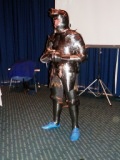 Andrew in full armour (Photograph by Dorothea Preis)
Andrew in full armour (Photograph by Dorothea Preis)
A real life vivid character next strode into the room clothed in full 15th century battle armour. Following a quick medieval striptease, the next speaker was revealed, slightly sweaty but ready to talk. Andrew (NSW) is an active historical jouster at an international level. Involvement with historical martial combat has given him a good working knowledge of the design, construction and function of medieval armour and for the next hour he spoke and answered a stream of questions from his audience. During this time he covered the history, function, making and different styles of armour as well as discussing war horses, knight training, knights on horse and foot and then bringing it all together into what happens in actual battle. As well as giving an overview of the knight in his world it was also an introduction into the world of trade and innovation that was generated by the making and selling of this tool of war. The 15th century is considered the peak of technical development of armour and weapons. Andrew’s suit was in the English style, so plainer than some continental makes but with wonderfully engineered articulated joints and protection, so it provided a great deal of movement and flexibility.
Following a business session with Rob (Australasian Vice President, NZ), which will be reported separately, the convention closed with an original piece written by Michael (Vic). Michael has invented the English Broadcasting Guild and written 3 radio style plays that have been ‘broadcast’ by the Guild at different Ricardian events. In this one, an Interview with Richard III, reporter Reginald Peacock (played by the author) is supported by Hazel delivering a delightful rich BBC accent, Kevin as Francis Lovell speaking about his life with Richard and Rob as Richard himself moving and very human with a well sustained and very real Yorkshire accent. This provided a very suitable ending to a weekend rich with new ideas and information, offering insights and a different angle on the facts and mysteries of Richard’s life and reign.
The closing formalities paid tribute to the NSW branch committee who organised the convention, with Rob proposing a vote of thanks and applause on behalf of the attendees. Thanks also went to Lynne for her invaluable work on the merchandise stall and to the many others who helped with the raffles and books sales and donated goods and time and energy to this most successful event.
In closing Master of Ceremonies, Ann, commented on the varied and detailed presentations that informed, instructed and entertained in turn and thanked all the speakers for their contributions.
All look forward to the next meeting in 2015 in New Zealand.
Denise Rawling and Helen Portus
Tags: Armour, Books, NSW Branch, Richard III, Richard III Society
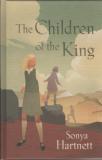 The Sydney Morning Herald reports that Sonya Hartnett was awarded this year’s Book of the Year: Younger Readers award for her novel The Children of the King at the Children’s Book Council of Australia Awards at the National Library of Australia yesterday.
The Sydney Morning Herald reports that Sonya Hartnett was awarded this year’s Book of the Year: Younger Readers award for her novel The Children of the King at the Children’s Book Council of Australia Awards at the National Library of Australia yesterday.



